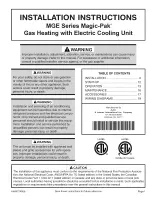
12
1. Operating instructions
for the User and the Qualified Installer
1.1 Description of the unit
The wall-mounted warm water heaters
„HFA Z 30 - 150 universal“
and the
„HFA/EB 80 Z“
are intended for heating up
cold water, in accordance with BS (British
Standard).
To suit requirements, they can provide hot
water up to approx. 82 °C and are
constructed in order to provide one or more
draw-off-points, depending on the operating
mode.
The water is heated electrically.
The water heater is provided with a
corrosion-protection by means of an
incorporated anode.
!
Infinite
temperature regulation possible
from about 35 °C to about 82 °C
A
(
1
).
!
The
heating process
is indicated by the
signal lamp
A
(
2
).
!
The
period required
for heating depends
on the storage content, the temperature
of the cold water, and the heating capacity,
see diagram
B
.
!
Hot water availability at
40 °C
Bath
Shower
Hand
Washing
=
ˆ
120 - 150 l =
ˆ
30 - 50 l
=
ˆ
2 - 5 l
The wall-mounted
warm-water-heater can
be used optionally
for:
!
unvented (pressurized systems)
for the
supply of several draw-off-points, or as
!
vented (pressureless systems)
, according
to the mode of operation, for the supply
of a point.
The
electrical installation
can be done
optionally:
!
Single-circuit operation
Automatic reheating takes place as a
function of the power supply.
!
Dual-circuit operation
These units provide basic heating, which
automatically heats up the water content
during off-peak periods. Rapid heating can
be switched on as required by pressing the
pushbutton
A
(
3
). When the preset
temperature is reached, the rapid heating
mode will be switched off and will not be
switched on again.
!
Boiler operation
With this switching mode, the unit heats
the water content once after being
switched on. Each heating process must be
switched on by pressing the button
A
(
3
).
1.2 The most important
points at a glance
A
Temperature selection button (
1
)
Signal lamps for operational mode
display (
2
)
Pushbutton for rapid heating (
3
)
Operation
Temperature selection button (
1
)
"
= cold (see also „Freezing risk“)
E
= (approx. 60 °C) recommended
energy saving setting, low
hardness scale formation
82 °C
= max. settable temperature.
Individual system conditions
may cause the temperatures
to differ from the reference
value.
The signal lamp (
2
) lights up during
heating in single-circuit and boiler
operation.
With dual-circuit operation, only with
rapid heating being required.
1.3 Important notes
!
A hot water temperature of more
than 60 °C may occur at the draw-off
fitting.
Children should accordingly be kept away
from the draw-off fittings
due to the risk
of scalding.
!
Arrange to have the wall-mounted water
heater and the safety group checked
regularly by a qualified installer.
!
Check your fittings regularly. Remove
limescale from the fitting outlets with
conventional scale removal products.
!
Units in unvented operational
mode
are under waterpipe pressure.
During heating, the expanding water drips
out of the safety valve. If water still drips
out after the heating process has finished,
inform your qualified installer.
!
The outlet pipe of the fitting must
always be free.
Do not use any perlators or aerators in
the fitting.
During each heating process, expansion
water drips out of the outlet.
In the case a mixing tap with a hand-
shower is used, a regular decalcifying is
necessary (to remove deposits of lime
and / or calcium).
Freezing risk
!
In
single-circuit mode
the unit is protected
against freezing, but the safety group and
the water pipe are not.
!
In
dual-circuit mode
, protection against
freezing only pertains during off-peak
periods.
!
In boiler mode there is no protection
against freezing.
1.4 Care and maintenance
Maintenance work, such as checking
electrical safety, may only be carried
out by a qualified installer.
A damp cloth is sufficient to take care of
the housing. Do not use any abrasive
media which might detach the coating.
1.5 Operating and
installation instructions
Keep these Instructions carefully. In
the event of a change of ownership,
hand them over to the new owners, and
give them to the qualified installer to read
in the event of maintenance and possible
repair work being carried out.










































